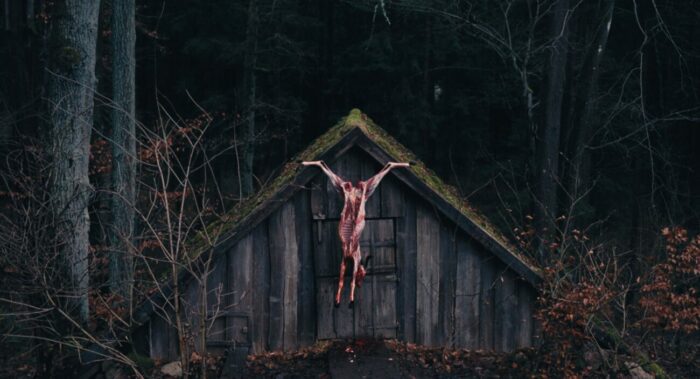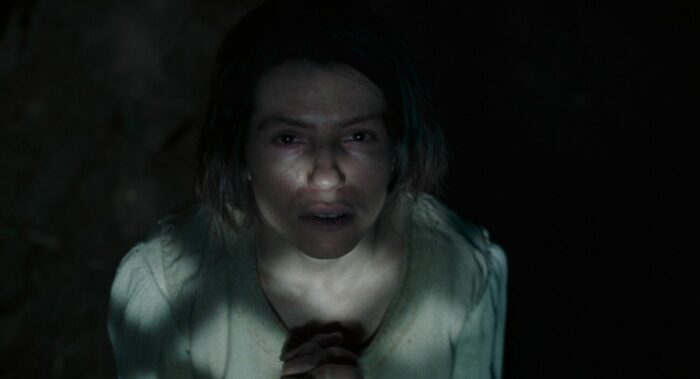When I first heard there was a movie called The Devil’s Bath, I was instantly intrigued. That name alone is enough to grab the interest of any self-respecting horror fan, but surprisingly, it’s not the most exciting thing about this film. The Devil’s Bath was directed by the duo behind Goodnight Mommy and The Lodge, two of the best horror movies of the last decade, and that’s what really made this an absolute must-see for me. I’ll watch just about anything these directors make, so I requested a screener right away and sat down to watch it as soon as I could.
The Devil’s Bath was directed by Veronika Franz and Severin Fiala, and it stars Anja Plaschg, Maria Hofstätter, and David Scheid. The film takes place in 18th-century Austria, and despite its demonic-sounding name, there’s actually nothing supernatural about it. See, back then, the phrase “devil’s bath” didn’t refer to a sort of satanic shower. Rather, it was a name for depression, and that’s what this story is really about.
It follows Agnes, a young woman who just married a man named Wolf, and at first, she’s deliriously happy. Agnes quickly discovers that marriage isn’t all it’s cracked up to be. Wolf almost completely ignores her, even when lying in bed together. Even his mother is a stereotypical overbearing mother-in-law. It’s just not a good situation, and it soon becomes too much for poor Agnes to bear. The woman descends into a deep depression, and that eventually leads her to commit an unspeakable act.
Right off the bat, I have to warn you that The Devil’s Bath isn’t a traditional horror movie. It plays more like a drama than anything else, and some people might even say it’s not a horror film at all. But make no mistake, this is one of the most horrific movies you’ll see all year, rightfully earning its spot in the horror family.
To begin, the film is loaded with creepy imagery from start to finish. For example, Agnes has a makeshift shrine that looks pretty spooky, and there are several shots of fish that somehow give off an A24-like vibe. There’s nothing inherently scary about those things, but they’re shot in such a way that they feel way creepier than they have any right to be.

However, not everything in The Devil’s Bath is like that. Some genuinely terrible things happen in this movie, and the directors take full advantage of those tragic events to craft some truly chilling visuals. For instance, we see a severed head in a cage pretty early on, and some time later, there’s a disturbing shot of a man hanging from the ceiling of his house.
One of the most horrific moments in this film involves the unspeakable acts some of the characters commit. I’m thinking of two in particular, and if you watch the movie, you’ll probably know what I’m talking about. They’re not all that gory (although we do see a bit of blood), but they’re carried out with the kind of cold-hearted callousness that would make Jason and Freddy proud.
On top of that overtly creepy imagery, The Devil’s Bath also excels at another, much more subtle kind of horror: the horror of depression. Like I said before, when the movie begins, Agnes is about as happy as can be. She’s super excited about her new life with her husband, and seeing her dreams crumble right in front of her eyes is absolutely heartbreaking.
It starts when Wolf surprises her by buying a house, and she’s not enamored with the place. Nevertheless, she tries to put on a happy face for him, but as the film goes on, the recurring mistreatment quickly snowballs out of control. It’s a fascinating and tragic progression that is anchored by an amazing performance from Anja Plaschg.
She’s the actress who plays Agnes, and everything this woman says and does is totally convincing. Whether her character is joyfully celebrating her wedding, longingly looking upon the Infant Jesus as she prays for a baby, or struggling to carry out her daily chores, you genuinely believe that she’s a real person going through this mental, physical, and emotional hell.

It’s a genuinely impressive performance, and when the titular “devil’s bath” really starts to take hold of the poor woman, Anja Plaschg gets even better. There are times when Agnes’ entire body shuts down, and Plaschg makes herself look like every ounce of life and strength has been sucked out of her. Other times, the character goes into a depressive rage, and in those scenes, Plaschg shows off a stark physicality that’s a bit reminiscent of the most lauded moments in Immaculate and The First Omen.
She just proves herself to be an all-around acting powerhouse, but more importantly, she also shows how horrific depression truly is. It’s one of the most terrible things a person can fall into, and The Devil’s Bath captures that horror in just about the most chilling way possible.
Granted, this film may not have the gross-out appeal or the jumpy fun of more typical genre fare, but it’s no less effective. It’s an emotional kind of terror that will seep into your bones and stick with you in a way those more in-your-face tactics only wish they could, so I don’t think anybody is going to walk out of this movie with a smile on their face (and I mean that in the best way possible!).
All that being said, I can’t quite say that The Devil’s Bath is a perfect film. As great as it is, it has one very noticeable flaw: it’s a bit too long. Without the credits, it’s around an hour and 50 minutes or so, and by the time I hit the 90-minute mark, I was already starting to feel the movie’s length. By my estimation, the filmmakers could’ve shaved off about 15 minutes without lessening the story’s impact, and that probably would’ve fixed those pacing issues.
But in the grand scheme of things, that’s little more than a glorified nitpick. On the whole, The Devil’s Bath is pretty much a masterpiece. It’s a heartbreaking exploration of the horror of depression fueled by one hell of a lead performance, so it’s probably the best film Veronika Franz and Severin Fiala have ever made. In fact, it’s one of my favorite movies of the year so far, and if you get the chance to watch it, I think you’ll enjoy the hell out of it too.
The Devil’s Bath will open at the IFC Center in New York on June 21, and it’ll be available to stream on Shudder starting June 28.




